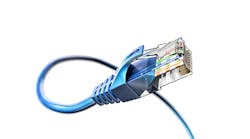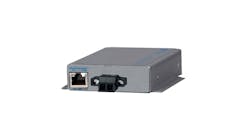The numerous barriers to deploying high-speed, Ethernet-enabled instrumentation in hazardous process automation facilities took yet another step forward with the formal introduction of Ethernet-APL, the new two-wire, intrinsically safe (IS) physical layer suitable for use in demanding process automation applications.
Ethernet-APL’s benefits include dramatically improved communication speed, hazardous-area reach, power to field instrumentation and long cable runs. Leading standards development organizations FieldComm Group, ODVA, OPC Foundation, and Profibus & Profinet International (PI), as well as 12 major industrial project partners, have worked together successfully over the past three years under “The APL Project” to create this new physical layer solution for field instrumentation. With the June release of the specifications, engineering guidelines and conformance test plans by the APL Project, end users can now expect components from leading suppliers, with first products now available from select vendors, according to a press statement released by the project's principals.
In short, Ethernet-APL is an extension of the specification for single-pair Ethernet (SPE) based on the 10BASET-1L standard, which can support every higher-order Ethernet communication protocol. By making adjustments to the physical layer, the requirements necessary for reliable operation in process-related plants are satisfied. These requirements include high-speed, Ethernet-based communications, safe operation in potentially explosive areas, and an ability to install long cable lengths up to 1,000 meters. The electrical parameters that an Ethernet-APL device must meet to ensure IS ignition protection are defined in the technical specification of the IEC TS 60079-47 standard (2-WISE or two-wire IS Ethernet).
“We're very pleased to release the carefully crafted technology specifications and engineering guidelines to enable Ethernet-APL technology to start to transform the field of process plants,” comments Dr. Jörg Hähniche, chair of the APL Steering Committee. “The high level of cooperation across multiple standards development and vendor organizations within the APL Project has resulted in one future-oriented Ethernet physical layer for process automation. This technology launch is a key progress marker, and the development journey will continue now with products in the pipeline from significant industry partners.”
The APL Project has defined port profiles to create the Ethernet-APL concept for multiple power levels with and without hazardous area protection. Ethernet-APL port profiles, including electrical power classes, shield connection options and segment lengths, have been finalized. Markings on devices and instrumentation will indicate power level and function as sourcing or sinking. This will provide a simple framework for interoperability from engineering to operation and maintenance. Engineering guidelines and best practices for planning and installation are also now complete, and available in an engineering directive document intended to support users when designing and commissioning networks using Ethernet-APL. These guidelines should help facilitate knowledge transfer to industry practitioners. Further, the use of standard Ethernet diagnostic tools will provide a shallow learning curve.
Multiple protocol support
As a single physical layer, Ethernet-APL will be able to support EtherNet/IP, HART-IP, OPC UA, Profinet or any other higher-level network protocol. Activities are underway to finalize conformance testing at the leading standards development organizations that are a part of the APL Project. The test specifications now published are intended to assure the quality of products and verify that a product complies with the parameters defined in the APL port profiles specification.
The APL Project team has also cooperated with semiconductor manufacturers that will offer the chips necessary for 10BASE-T1L Phys for Ethernet-APL. Additionally, the 12 APL Project industry partners are finalizing development of products that will be available in the marketplace soon. The multivendor demonstration in Karlsruhe, Germany—displayed digitally during ACHEMA Pulse, July 15-16, showing participation across different product vendors and networks—highlighted the multiple options and interoperability that Ethernet-APL will offer end users.
With the launch of Ethernet-APL, users can now anticipate a single Ethernet physical layer that will enable long cable reach, intrinsic safety and application-level protocol support for maximum productivity and output. Products will be available in the market soon with conformance testing certification. Users can learn more about Ethernet-APL by visiting ethernet-apl.org and downloading the “Ethernet to the Field” whitepaper.
Familiar topology
Ethernet-APL is designed to support trunk-and-spur installations and redundancy concepts similar to the fieldbus options that came before it. Two general types of segments are defined: trunk lines that carry high-level power and data for distances up to 1,000 meters (m), and spur lines that carry power and signals with optional intrinsic safety for distances up to 200 m. Anchoring the trunks are APL Power Switches, each of which provides up to 60 W of power and communications for as many as 50 devices. Anchoring each spur, in turn, is an APL Field Switch that provides IS power and communications to the field devices themselves.
Ethernet-APL requirements for IEC 61158 Type A shielded, twisted-pair cables are also in line with established fieldbus practices, and the newly released engineering guidelines include help in selecting the correct cabling for a given APL application.
“As fieldbus cable has been designed for 31.250 kB, not all existing cable can be used for APL at the full cable length,” notes Michael Kessler, executive vice president, components and technology, Pepperl+Fuchs. “Therefore the APL port profile specification defines for different categories supporting spur / trunk cable lengths of 50 m / 250 m, 100 m / 500 m, 150 m / 750 m and 200 m / 1,000 m. Manufacturers have to specify their cable by this classification.”
“From the very outset, the ability to reuse existing single, twisted-pair fieldbus cabling was a requirement for APL due the high installation costs involved,” says Michael Bowne, executive director, PI North America. “For example, the Type A cabling used by Profibus PA should work just fine for APL.
“But whether greenfield or brownfield, we highly recommend users perform a network infrastructure baseline test as part of any installation,” Bowne adds. “This involves ensuring all wiring is performing as intended. Cable testers are available from various manufacturers that verify cable integrity and electrical properties. As long as the wiring meets the resistance, inductance and capacitance ratings specified, users should be good to go. Confidence in the initial network infrastructure also helps relieve worries down the road if errors crop up.”
Migration and adoption
As with any new technology aimed at supplanting “perfectly good” operational devices and entrenched work practices, the adoption of APL—for process facilities both greenfield and brown—will likely take time to gather momentum, even with the most compelling of value propositions.
“Where FOUNDATION fieldbus and Profibus PA are currently used, we don’t believe that end users will start ripping out field instruments to install APL,” adds Paul Sereiko, director of marketing at FieldComm Group. “We doubt a refinery unit will consider upgrading until their existing assets are at end of life. Early adopters are much more likely in more flexible process applications, such as life sciences, and food and beverage.”
“Any protocol that runs on Ethernet today can be used over Ethernet-APL,” notes Andy Kravitz, flow transmitter marketing manager and working group representative for Emerson. And that includes HART-IP and Profinet as well as EtherNet/IP and other industrial Ethernet variants once generally excluded from hazardous-area duty. “Ethernet-based protocols such as these have provisions for using I/O that can communicate with devices using legacy digital protocols such as analog HART, Profibus PA and FOUNDATION fieldbus.
“Initially, we expect customers to continue making decisions based on comfort, cost and capability,” Kravitz continues. “But over time, as instrumentation and system vendors provide more support for Ethernet-APL, we expect customers will select Ethernet-APL devices due to the potential for increased capability, security and flexibility.”
“FOUNDATION fieldbus and Profibus PA will be first to lose ground to APL,” predicts Taro Endoh, Yokogawa's representative on the APL working groups. “APL with industrial Ethernet protocols will replace conventional digital protocols first, then 4-20mA and HART in the not so distant future.”
But APL vs. current fieldbus protocols doesn’t have to be an all-or-nothing proposition, according to Kessler of Pepperl+Fuchs. “Ethernet-APL switches have been demonstrated to provide Ethernet-APL spur interfaces with dual functionality, such as Profinet-APL and Profibus PA,” Kessler says. “Theoretically, this is also feasible with a FOUNDATION fieldbus instrument where its data can be mapped on any Ethernet-based, real-time protocol. This dual-functionality is important to migrate existing plants to Ethernet-APL-based infrastructure. During the next several years, existing FOUNDATION fieldbus or Profibus PA instruments may fill the gap of missing instrument functions with an Ethernet-APL interface.”
It’s also important to note that the non-fieldbus, analog and HART segment of the market is also currently the largest—both in terms of installed base and current greenfield plant design and construction. Indeed, a wholesale shift to APL will require revamped systems and engineering practices away from the now widespread practice of configurable I/O in which DCS suppliers have invested so much money and effort over the past 10 years.
And, of the four standards development organizations involved in the APL Project, ODVA and its EtherNet/IP protocol may stand to gain the most from an APL standard. “Today, EtherNet/IP is commonly used in process automation in ‘islands of automation’ for applications, such as valve piloting where a PLC, which also serves as a gateway to a DCS, controls a bank of directional control valves,” explains Steve Fales of ODVA.
With APL, Fales predicts that EtherNet/IP will be used more broadly across process networks—without gateways—for control, diagnostics and commissioning.
Meanwhile, the OPC Foundation and its Field Level Communications (FLC) Initiative is another dark horse in the APL protocol sweepstakes. With its built-in communications and security models, extensions to OPC UA could effectively obviate the need for any of the "traditional" bus protocols.
Tilo Merlin, platforms manager, ABB Measurement & Analytics, adds: “Since most DCS systems already support Profinet and EtherNet/IP today, adoption of Ethernet-APL paired with these protocols will be straightforward. As direct usage eliminates the use of gateways or other protocol conversions, it will significantly reduce complexity and cost of ownership, and improve usability and robustness compared to traditional fieldbus solutions.
“Beyond applying those established Ethernet-based protocols,” Merlin continues, “APL enables use of new protocols such as OPC UA, offering new levels of security and semantics, and so breaks the border between IT and OT.”
An onramp to secure digital twins
Even as the APL Project has been working to extend an IIoT-sized expressway to field instruments, work has progressed on complementary standards from the software and systems side of the world that are poised to take full advantage of that new bandwidth. Notable among these are FDI and PA-DIM—each of which promises to bring new order and value to the digital field.
“FDI and PA-DIM are all about making it easier for software systems throughout the enterprise to consume information provided by instruments,” explains Sereiko of FieldComm Group. “Ethernet-APL is all about replacing gateways and remote I/O with Ethernet switches to facilitate the routing of the information from the device to the enterprise system. Ultimately, it’s possible that the higher speeds enabled will lend themselves to feature enhancements for FDI and PA-DIM that further simplify device integrations.”
“As a technology, FDI and PA-DIM are designed to help lower the bar for pulling information from field devices,” adds Emerson’s Kravitz. “Given that Ethernet-APL increases the bandwidth to individual devices, we expect the combination of all of these technologies will help drive customers to more fully utilize the capabilities of our devices more easily than ever before. This will enable field devices to easily integrate with every level of the process data ecosystem from the control system all the way to the cloud.”
Ethernet-APL and PA-DIM in combination offer the possibility to access data from the field in a parallel communication path to the control integration, notes Lukas Klausmann of Endress+Hauser. “This second-channel approach supports the concept of NAMUR Open Architecture (NOA) without influencing core automation processes,” Klaussmann says. “This is the basis of plant-wide availability of data, and its easy interpretation without need for device-specific drivers. The possibilities of such digital services are numerous, and offer extensive support for optimization efforts and efficiency improvements in a process plant.”
Ethernet-APL is the key enabling technology to deploy OPC UA and PA-DIM in the field devices themselves, adds Pepperl+Fuchs’ Kessler. “This will finally allow real plug-and-play since the device will come with an embedded information model—that means no need for any kind of device description. FDI, meanwhile, will allow the use of PA-DIM for legacy instruments. This will help with plants migrating from HART or fieldbus to Ethernet-APL.”
Models and standards such as FDI are important tools for customers and vendors, but adoption rates are always slower when speed, infrastructure and connectivity to higher-level systems requires new cabling or even gateways, says Scott Saunders, president/CEO of Moore Industries. “Ethernet-APL goes a long way by removing all these issues," he adds. "Supporting most existing installed, twisted-pair cabling with speeds of 10 Mbps, and supporting most all other TCP/IP-based industrial protocols simultaneously, helps assuage the concern end users typically have that hamper new and emerging standards introduced in our industry.”
“A whole world of new use cases become possible with APL,” adds Bowne of PI North America. “It plays directly into the IT/OT network convergence that’s occurring across industries. With a common Ethernet-based physical layer, vendors are free to implement multiple protocols on their instruments, a feature long established in factory automation. It also helps enable concepts like NAMUR Open Architecture for unidirectional communication to higher-level systems outside the traditional automation pyramid.”
The fact that Ethernet-APL supports the full Ethernet stack means that all the additional features of the IEEE world are available to increase usability, says ABB’s Merlin, citing Link Layer Discovery Protocol (LLDP), an out-of-the-box tool available once you’re part of the Ethernet ecosystem.
“The general multi-protocol capability of Ethernet is far-reaching,” Merlin says. “It makes the secure bridging between OT and IT world a lot easier. And due to universal applicability of OPC UA from field level to cloud, APL is a cornerstone to connect physical assets to their digital twins.”
Reader feedback
It’s important to note that Ethernet-APL is not just for traditional instrumentation. Imagine other products that could benefit from APL: video cameras, IR cameras, local operator panels, LiDAR etc. These are high data-rate products that can make better use of 10 Mbit/s than a temperature transmitter. More thoughts here: https://www.linkedin.com/pulse/ethernet-apl-converged-ip-everywhere-field-jonas-berge/
APL also supports common ICT protocols like HTTPS for web browsing and RTSP for video. This opens for interesting new device capabilities and new kinds of devices. I think APL will be mostly greenfield projects. I agree with Michael Kessler of Pepperl+Fuchs that Foundation Fieldbus and Profibus PA instruments may fill the gap of devices missing APL since they can use the same infrastructure. There will be a mix of APL and non-APL. Maybe a simple sensor will not be APL, but also share the same single infrastructure.
Here’s an interesting silicon chip from Analog Devices that enables a device to be all three and facilitate potential migration: https://www.analog.com/en/products/adin1102.html. Higher networks will use OPC-UA regardless of what the field devices use.
Jonas Berge
Senior Director, Applied Technology
Emerson
[email protected]






